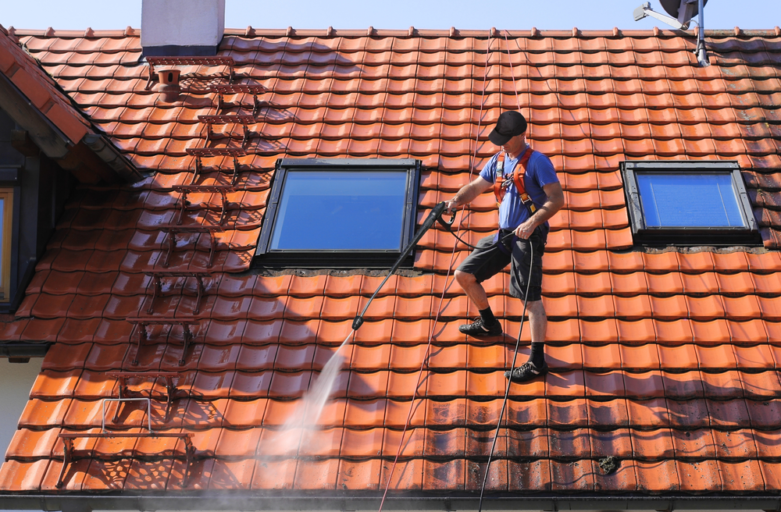A clean roof will help protect against mold exposure, maintain your home’s value, and extend its lifespan. It also minimizes the chance of moss or algae growth, causing damage to the roof structure and potentially voiding your warranty.
Washing your roof in small sections is important as it can be a slipping hazard when wet. Proper safety equipment and knowledge before cleaning a roof is also important. Contact Sea Clear Window Washing & Pressure Cleaning LLC now!

Debris removal is a very important part of roof cleaning, as debris on the roof can clog drains and cause other problems. It is also a good opportunity to look at the structure of your roof and see if any damaged areas need repair.
Unless you are comfortable on the roof, this task is best left to professionals who can safely use a ladder to remove large piles of debris like pine needles or dry leaves. If the debris is heavy, they may need a special tool to remove it.
For smaller piles of debris, a broom with stiff bristles can be used to sweep it off the roof. If this is done regularly, it can prevent larger buildups from occurring on the roof. This is especially important for homes with trees nearby, which can shed twigs and branches daily.
Once all the debris is removed, a cleaning solution should be applied to the roof to clean it. This could be a mixture of water and detergent, or it could be a bleach solution. Whatever solution is used should be scrubbed onto the roof and allowed to soak in for a few minutes before being rinsed off. The rinsing process should be repeated to remove all the cleaning solution from the roof.
If there are any stains left behind, they can usually be washed away with a hose. However, be careful not to apply too much pressure, as this can damage individual tiles. If the stains persist, a stronger solution may be needed.
A final step of roof cleaning is to blow the debris from the gutters and downspouts. This step is very important, as it will ensure the entire gutter system works properly. It will also be an excellent time to examine the drains and gutters for clogs or signs of wear and tear. It is recommended to take this opportunity to inspect the chimney, skylights, and any other roof protrusions as well.
Algae stains can be unsightly and damage asphalt shingles, causing them to break down. A regular roof cleaning removes the stains and prevents them from returning, but algae can still grow on your roof if it’s not treated. To avoid damaging your roof and lowering its life span, algae should be cleaned as soon as you see it growing.
You can safely clean algae from your roof using a solution of water and bleach. However, you should test the mixture on a small roof before spraying it. Wetting down any foundation plants that will receive runoff from your roof before you begin washing is also a good idea. This will protect them from the harsh bleach and reduce any long-term effects.
Moss and algae are often the result of improper drainage or moisture buildup on a roof. The right gutters, downspouts, and venting can properly ensure water flows away from your house. You should also cut back any trees that are hanging over your roof to eliminate the shade that encourages moss and algae growth.
If you have a shingle roof, many products can be applied as a spray or foam to kill the algae and prevent it from growing back. You should always use a product that is designed for your type of roof. A metal roof requires a different product, such as an ammonia solution or oxygen bleach.
Another way to inhibit the growth of algae is by installing strips of copper or galvanized metal along the roof’s ridge. The metal is toxic to algae, and the streaks of color from the dead algae will be eliminated from your roof.
Lastly, you should use a biocide to prevent the future growth of lichen, algae, and moss on your roof. You can find biocide at most home improvement stores, and it should be safe to use on your roof. This is a great way to protect your investment in your roof and improve your curb appeal. This product also helps protect the environment by preventing pollutants and harmful bacteria from entering bodies of water.
Your roof protects your home and the people inside it, so it’s important to keep it clean. A professional can ensure that your roof is free of dirt, mildew, moss, and other debris that can deteriorate over time. They can also make recommendations for how often your roof should be cleaned to maintain optimal performance and lifespan.
While many homeowners have pressure washers at home, using them on your roof can damage it. High-powered water at 1,300 to 2,800 pounds per square inch (psi) can blast away debris, erode roofing tiles, and degrade metal roof coatings and paints. These extremes can void your roof warranty and cause other problems.
Instead, professionals use a different cleaning method that’s safe for your roof. Soft wash roof cleaning combines low-pressure washing with eco-friendly chemical solutions to safely remove mildew, mold, asphalt shingle staining, and other organic growths. The cleaning solution can penetrate deep into the surface, killing organisms and disintegrating their cell structure. Then, the cleaning solution is rinsed off the surface.
Depending on the roof material, your cleaning pro may choose to pre-treat the entire surface of your roof and surrounding surfaces with water and detergents before they begin. They’ll also set up temporary piping around your property to capture runoff and redirect it into storage containers to prevent the spread of contaminants to your grass, trees, shrubs, and landscaping.
These precautions add to the overall cost of the job. They’ll also spend more time on your roof if it’s larger or has multiple levels, as they’ll have to work at a higher elevation.
If your roof is prone to moss, you’ll need an additional treatment that destroys it and prevents it from growing back. Moss is particularly difficult to remove from a roof as it grows between shingles and cracks. The cost of this treatment varies but can be up to $0.20 per square foot. In addition to killing organisms, the treatment contains antifungal and anti-algae chemicals that protect your roof from future growth. These agents can take a few days to kill off the unwanted growths.





